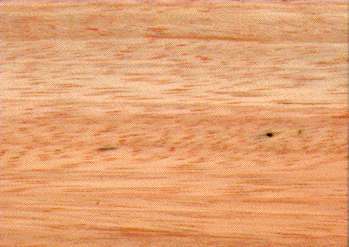
Gogbi (Calpocalyx brevibracteatus)
Family: Leguminosae
Common names: Gogbi, Jugbe, Kolei, Kondo, Kotopapa, Kotoprepre, Kpu-eh, Mano, Okpagheze, Otuen, Petepre, Samanta, Teli, Tili, Tre-tre, Yinni
Distributed in: Benin, Cameroon, Ghana, Ivory Coast, Liberia, Nigeria, Sierra Leone, Togo (Africa)
Common uses: Boat building (general), Heavy construction, Poles, Posts, Railroad ties, Tool handles
Tree size: Tree height is 10-20 m
Colors: the heart isRed, Reddish brownand the sapwoodDifferent than heartwood, White to yellow.The grain isStripe (figure), the textureFineand the lusterDull
Natural durability: Resistant to powder post beetles, Susceptible to insect attack
LightInduced Color Change: None
Kiln Drying Rate: Naturally dries slowly
Ease of Drying: Slowly
Tree Identification: Bole/stem form is not buttressed
Cutting Resistance: Fairly Difficult to Very Difficult to saw
Gluing: Fairly Easy to Very Easy
Nailing: Fairly Difficult to Very Difficult
Planing: Fairly Easy to Very Easy
Response to hand tools: Difficult to machine
Polishing: Fair to Good;
- Numerical data Metric
- Numerical data English
- Strength properties
- References
 |
 |
 |
 |
| Item |
Green |
Dry |
Metric |
| Specific Gravity |
|
|
|
| Density |
|
849 |
kg/m3 |
| Bending Strength |
954 |
1473 |
kg/cm2 |
| Crushing Strength |
485 |
699 |
kg/cm2 |
| Hardness |
|
1051 |
kg |
| Impact Strength |
|
|
cm |
| Shearing Strength |
|
|
kg/cm2 |
| Stiffness |
152 |
175 |
1000 kg/cm2 |
| Tangential Shrinkage |
|
|
% |
| Radial Shrinkage |
|
|
% |
| Weight |
|
|
kg/m3 |
| Maximum Load |
|
|
cm-kg/cm3 |
| Toughness |
|
|
cm-kg |
| Static Bending |
|
|
kg/cm2 |
|
 |  |  |  | | Item | Green | Dry | English | | Bending Strength | 13576 | 20956 | psi | | Density | | 53 | lbs/ft3 | | Hardness | | 2318 | lbs | | Maximum Crushing Strength | 6899 | 9945 | psi | | Stiffness | 2167 | 2494 | 1000 psi | | Weight | 52 | 42 | lbs/ft3 | |
Density (dry weight) = 53-60 lbs/cu. ft
Max. crushing strength = high
Density (dry weight) = 46-52 lbs/cu. ft.
Bending strength (MOR) = high
Modulus of Elasticity (stiffness) = high
Hardness (side grain) = hard
Cooper, G.P., Record, S.J.,1931,The Evergreen Forests of Liberia,Yale School Forestry Bulletin,31,pp1-153Dalziel, J.M.,1937,The Useful Plants of West Tropical Africa,Crown Agents for the ColoniesDudek, S.,1981,Lesser Known Liberian Timber Species,German Agency for Technical Cooperation GermanyIrvine, F.R.,1961,Woody Plants of Ghana,O.U.P. LondonKeay, R.W.J.,1964,Nigerian Trees Vol.2,Nigeria Federal Department of Forest Research, IbadanKryn, J.M., Forbes, E.W.,1959,The Woods of Liberia,U.S.A. Department of Agriculture,Forest Products Laboratory, Madison,,Report No. 2159Savill, P.S., Fox, J.E.D.,1967,Trees of Sierra LeoneTakahashi, A.,1978,Compilation of Data on the Mechanical Properties of Foreign Woods (Part,III) Africa,Shimane University, Japan, Research Report on Foreign Wood No. 7Voorhoeve, A.G.,1965,Liberian High Forest Trees,Centre for Agric. Publishing and Documentation, Wageningen
|








